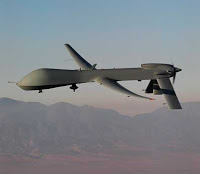Rick Rozoff
Global Research
Last week the Washington Post, the New York Times and other major American newspapers reported that the U.S. launched its first unmanned aerial vehicle (drone) missile attack inside Somalia.
The strike was the first acknowledged Pentagon military attack inside the Horn of Africa nation since a helicopter raid staged by commandos in 2009 and the first use of an American drone to conduct a missile strike there. Drones had earlier been used in the country in their original capacity, for surveillance, including identifying targets for bomb and missile attacks, one being shot down in October of 2009. But as Britain’s The Guardian reported on July 30, the strike in Somalia marked “the expansion of the pilotless war campaign to a sixth country,” as the remote-controlled aircraft have already been employed to deadly effect in Afghanistan, Iraq, Pakistan, Yemen and most recently Libya.
The lethal Somali mission was reportedly carried out by the U.S. Special Operations Command, in charge of executing special forces operations of the respective units of the four main branches of the American military: The Army, Marines, Air Force and Navy. On July 4 the U.S. armed forces publication Stars and Stripes reported that there are currently 7,000 American special forces in Afghanistan and another 3,000 in Iraq, with the bulk of the latter to be transferred to the first country in what was described as a “mini-surge” of special operations troops to compensate for the withdrawal of 10,000 other troops from Afghanistan by the end of this year.
Last week BBC News reported on the proposed transfer of drone aircraft by the U.S. to its military client states Uganda and Burundi for the war in Somalia. Citing American defense officials, BBC disclosed that four drones will be supplied to the two nations who have 9,000 troops engaged in combat operations against anti-government insurgents in the Somali capital of Mogadishu.
According to a New York Times feature of July 1: “[T]he United States has largely been relying on proxy forces in Somalia, including African Union peacekeepers from Uganda and Burundi, to support Somalia’s fragile government. The Pentagon is sending nearly $45 million in military supplies, including night-vision equipment and four small unarmed drones, to Uganda and Burundi to help combat the rising terror threat in Somalia. During the Ethiopian invasion of Somalia in 2007, clandestine operatives from the Pentagon’s Joint Special Operations Command initiated missions into Somalia from an airstrip in Ethiopia.”
On June 15 a major newspaper in the United Arab Emirates, The National, reported on the escalation of deadly U.S. drone attacks in Yemen, across the Gulf of Aden from Somalia. It cited an official with the Yemeni Ministry of Defense claiming that the U.S. had launched over 15 drone strikes in the country in the first two weeks of June. The newspaper also quoted the deputy governor of Abyan province, Abdullah Luqman, decrying the attacks and stating: “These are the lives of innocent people being killed. At least 130 people have been killed in the last two weeks by US drones.”
The leader of an observation committee created to evacuate local residents added that “more than 40,000 people have left Abyan province because they feared drone strikes.”
The same defense official mentioned above warned that the “United States is turning Yemen into another Pakistan.” [1]
Recent reports in the American press reveal that the Pentagon will establish a new air base in the Persian Gulf from which to intensify drone strikes in Yemen. According to a Russian source, “The location is kept secret but some say this might be Bahrain as it already has a US base [the headquarters of the U.S. Fifth Fleet] and provides the safest route to Yemen for US drones through American ally Saudi Arabia.” [2]
 The drone missile assaults in Pakistan, which caused a record number of deaths – over 1,000 – last year, are carried out by the Special Activities Division of the Central Intelligence Agency, whose last director is the new secretary of defense, Leon Panetta, a transfer that presages a yet greater intensification of the deadly attacks inside the South Asian nation.
The drone missile assaults in Pakistan, which caused a record number of deaths – over 1,000 – last year, are carried out by the Special Activities Division of the Central Intelligence Agency, whose last director is the new secretary of defense, Leon Panetta, a transfer that presages a yet greater intensification of the deadly attacks inside the South Asian nation.On June 5 the 40th drone strike of the year killed at least six people in South Waziristan in Pakistan’s Federally Administered Tribal Areas, bringing the death toll this year to at least 350.
Late last month the Pakistani government ordered the U.S. to vacate the Shamsi Air Base in the province of Balochistan which had been used for drone strikes inside the nation. Washington has in the interim shifted those operations to upgraded air bases in Afghanistan near the Pakistani border. A recent poll conducted by the Pew Research Center found that only 3 percent of Pakistanis support the drone attacks in the country’s tribal belt.
At the end of June, 28 people were reported killed by drone strikes in the South Waziristan Agency, with a local resident quoted by Pajhwok Afghan News as stating “that 20 civilians were killed and several others injured in the second attack.” [3]
Some 2,100 of the 2,500 people killed in the strikes since they began in 2004 have lost their lives since 2009, when Barack Obama became the president of the U.S. and Leon Panetta director of the Central Intelligence Agency.
On July 5 a British Reaper drone killed at least four Afghan civilians and wounded two more in a missile attack in Helmand province. The use of the Reaper, rightly referred to as the world’s deadliest drone, marks the crossing of an ominous threshold. It is the first of what is described as a hunter-killer – long-endurance, high-altitude – remote-piloted aircraft that can be equipped with fifteen times the amount of weaponry and fly at three times the speed of the Predator used in Iraq, Afghanistan, Pakistan, Yemen, Somalia and Libya. (The U.S. has used Reapers in Iraq since 2008 and in Afghanistan starting the following year. Toward the end of 2009 the Pentagon deployed Reapers to the East African island nation of Seychelles along with over 100 military personnel.)
On June 28 the U.S. lost the third of three drones in Afghanistan in as many days.
A recent Refugees International report stated that over 250,000 Afghans have been forced to flee their towns and villages during the last two years, over 91,000 so far this year: “Not only have NATO-led troops and Afghan forces failed to protect Afghans, but international airstrikes and night raids by U.S. Special Forces were destroying homes, crops and infrastructure, traumatising civilians and displacing tens of thousands of people.” [4]
RELATED ACTIVIST POST ARTICLE:
var linkwithin_site_id = 557381;
linkwithin_text=’Related Articles:’



Be the first to comment on "Risk-Free And Above The Law: U.S. Globalizes Drone Warfare"